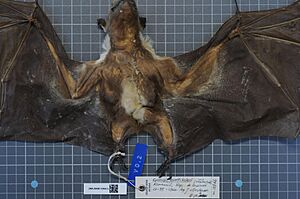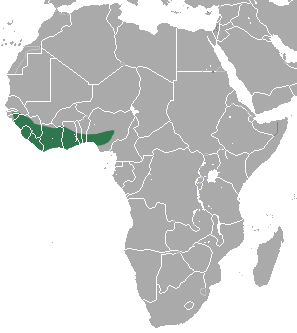Buettikofer's epauletted fruit bat facts for kids
Quick facts for kids Buettikofer's epauletted fruit bat |
|
|---|---|
 |
|
| Conservation status | |
| Scientific classification | |
| Genus: |
Epomops
|
| Species: |
buettikoferi
|
 |
|
| Buettikofer's epauletted fruit bat range | |
| Synonyms | |
|
|
The Buettikofer's epauletted fruit bat (scientific name: Epomops buettikoferi) is a type of large bat. It belongs to a family called Pteropodidae, which are often known as fruit bats. You can find this bat in West African countries like Ivory Coast, Ghana, Guinea, Guinea-Bissau, Liberia, Nigeria, Senegal, and Sierra Leone. It likes to live in warm, wet forests and open savanna areas.
Contents
About This Bat
How It Got Its Name
This bat was first described in 1899 by a German zoologist named Paul Matschie. He gave it the name Epomophorus büttikoferi. The first bat of this kind that scientists studied was found in Liberia. Matschie named the bat after Dr. Johann Büttikofer. Dr. Büttikofer was a scientist who explored Liberia many times.
For a while, some scientists thought this bat was just a type of Franquet's epauletted fruit bat. But in 1975, another scientist named Bergmans showed that they were different enough to be separate species. However, a study in 2016 suggested they might be very closely related after all. This means scientists are still learning about how these bats are connected.
What It Looks Like
Male Buettikofer's epauletted fruit bats are bigger than females. Males usually weigh about 164–198 g (0.362–0.437 lb). Females are lighter, weighing around 85–132 g (0.187–0.291 lb).
This bat looks a lot like the Franquet's epauletted fruit bat. But you can tell them apart by a few things. The Buettikofer's bat has longer forearms. Males have forearms longer than 91 mm (3.6 in). Females usually have forearms longer than 86 mm (3.4 in). It also has a longer skull and a longer first tooth.
What It Eats and How It Lives
Buettikofer's epauletted fruit bats mostly eat fruit. In Ivory Coast, almost half of their diet comes from the fruits of the Cape fig and another fig tree called Ficus vallischoudae.
Scientists don't know much about how these bats have babies. It seems they might have two breeding seasons each year. Pregnant females have been seen in January and July. Young bats have been found in March and August. This idea is supported by studies in Liberia. There, births happened in February–March and August–September. These times match up with the two wet seasons of the year.
Where It Lives
The Buettikofer's epauletted fruit bat lives in West Africa. In the western part of its home range, it can be found in the same areas as the Franquet's epauletted fruit bat.
In countries west of Ghana, this bat is one of the most common types of fruit bats. It usually lives in low-lying areas. But it has also been found high up on Mount Nimba. This is an elevation of about 1,200 m (3,900 ft) above sea level.
Its Conservation Status
The IUCN (International Union for Conservation of Nature) has been checking on this bat since 1994. From 1994 to 2004, it was listed as a vulnerable species. This means it was at risk of becoming endangered. But from 2004 until now, it has been listed as least concern. This means it is not currently at high risk.
Some of the places where this bat lives are protected areas. But it can also do well in areas that are not officially protected. People sometimes hunt these bats for bushmeat. However, scientists are not sure how much this hunting affects the bat's total population.


